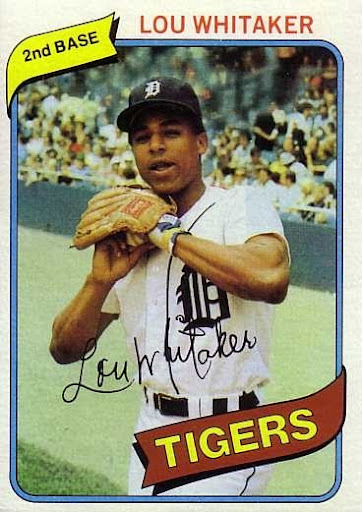September 9, 1977: Whitaker and Trammell make their debut
When Detroit Tigers manager Ralph Houk wrote out the lineup card for the second game of a twi-night doubleheader at Fenway Park on September 9, 1977, a couple of new players were making their major-league debuts. They had been called up from Double-A Montgomery a few days before, where they had spent the summer as the double-play combination for the pennant-winning Rebels, and they were two of the biggest prospects in the Tigers’ system. The players were Lou Whitaker and Alan Trammell. They would go on to play 19 years together in the Motor City, ending their careers as the longest-running keystone combination in major-league history.
 The game, at least for the Tigers, seemed inauspicious enough. At 67-74, they were merely playing out the string. The Sox trailed the first-place Yankees by three games, and would wind up the ’77 campaign in a disappointing second place. Still, Houk wanted to get a good look at whom he referred to as “those two young kids.”1
The game, at least for the Tigers, seemed inauspicious enough. At 67-74, they were merely playing out the string. The Sox trailed the first-place Yankees by three games, and would wind up the ’77 campaign in a disappointing second place. Still, Houk wanted to get a good look at whom he referred to as “those two young kids.”1
Trammell, a 19-year-old from San Diego, used to sneak into Jack Murphy Stadium as a youth to watch the hometown Padres. He had recently been named MVP of the Southern League, where he hit .291 with 19 triples. “I’ll never forget the first time I saw Trammell (in spring training),” Houk reminisced years later, “because he was wearing yellow shoes.”2 As Whitaker remembers it, “Tram was a hippie back then. He came out of high school with long hair. He liked that heavy metal.”3 Whitaker, nearly a year older than Trammell and just as skinny, was born in Brooklyn but had gone to high school in Virginia. He was dubious about signing his first pro contract, reasoning that he didn’t have a proper wardrobe. Scout Bill Lajoie bought him two suits, and Whitaker put pen to paper.
 Of the two, Whitaker was thought to be farther along as a hitter. Both were slick fielders, with soft hands and strong, accurate arms, and Whitaker could make the pivot with the best of them. Actually, Whitaker had begun his minor-league career as a third baseman. The Tigers, however, already had an established third sacker in Aurelio Rodriguez, so they switched Whitaker to second. Thus, it was at the Fall Instructional League, after the 1976 season, that Whitaker and Trammell were first paired together at second and short. (It would have happened earlier if Jim Leyland, Whitaker’s manager at Class A Lakeland (Florida) in 1976, hadn’t stepped in: “They wanted me to switch him over toward the end of the season and I begged them. I said ‘Look, I don’t think this is a good time. This guy is a top prospect and he’s going to be a big leaguer for a long time. I’d hate to take a chance and see him get hurt playing second base when someone slides into him.’”4)
Of the two, Whitaker was thought to be farther along as a hitter. Both were slick fielders, with soft hands and strong, accurate arms, and Whitaker could make the pivot with the best of them. Actually, Whitaker had begun his minor-league career as a third baseman. The Tigers, however, already had an established third sacker in Aurelio Rodriguez, so they switched Whitaker to second. Thus, it was at the Fall Instructional League, after the 1976 season, that Whitaker and Trammell were first paired together at second and short. (It would have happened earlier if Jim Leyland, Whitaker’s manager at Class A Lakeland (Florida) in 1976, hadn’t stepped in: “They wanted me to switch him over toward the end of the season and I begged them. I said ‘Look, I don’t think this is a good time. This guy is a top prospect and he’s going to be a big leaguer for a long time. I’d hate to take a chance and see him get hurt playing second base when someone slides into him.’”4)
Houk inserted Whitaker second in the lineup, following leadoff hitter Ron LeFlore. In his first time up, Tiger fans got a glimpse of the speed that had allowed Sweet Lou to steal 86 bases in his previous two minor-league campaigns. Facing Reggie Cleveland, he singled with one out, stole second, and later advanced to third after Cleveland threw the ball wildly into center field on a pickoff attempt. He was left stranded, however, when the inning ended.
Trammell, batting ninth, stepped to the dish for the first time in the top of the third, and promptly singled to center. A walk to LeFlore put Trammell on second. He scored on a double by none other than Whitaker, who himself was driven in moments later by Steve Kemp.
Both rookies struck out in the fourth and singled to center in the sixth. In the eighth, Whitaker struck out, and Trammell was pinch-hit for by Bob Molinaro in the ninth. When the final bell was rung late into the New England night, the Tigers had fallen to the Red Sox, 8 to 6.
The two rookies had combined for five hits and two runs. It was a fine first game together, to be followed by 1,917 more, an American League record for teammates. They went on to have the most double plays in baseball history, as a unit, but would not get one in this game (That would have to wait until the next day’s contest, when Fred Lynn hit into a 4-6-3 double play in the first inning.). In the field, Whitaker had no chances, while Trammell had one putout (a foul popup, by Carl Yastrzemski, in the first inning) and one assist (a ground ball, short to first, in the third off the bat of Butch Hobson).
Sparky Anderson, their manager for many magical summers in Detroit, summed it up after their careers had ended: “You know, you can talk about DiMaggio’s 56-game hitting streak, and some of these other records that will never be broken. Well, you’ll never see two players spend 19 years together like Lou and Alan did.”5
“There’s no question (they) were extraordinary in the way they lasted together,” noted longtime Tiger radio announcer Ernie Harwell. “It’s a remarkable record.”6
And it all began on an unremarkable evening at Fenway Park.
“I didn’t think we’d be married so long,” Whitaker quipped as the curtain began to close on their act. “We’ve been together longer than lots of husbands and wives.”7
Notes
1 Dan Holmes. “Trammell and Whitaker Debuted Together 35 Years Ago,” Detroit Athletic Company, http://blog.detroitathletic.com/2012/09/09/looking-back-at-the-careers-of-trammell-and-whitaker/, accessed January 8, 2014.
2 John Valerino. “It Was a Match Made in Baseball Heaven,” TheBaseballPage.com, http://www.thebaseballpage.com/community/articles/it-was-match-made-baseball-heaven, accessed January 8, 2014.
3 Associated Press. “A Perfect Pair: Trammell-Whitaker Combo Makes History,” Toledo Blade, September 14, 1995.
4 Valerino.
5 Ibid.
6 Ibid.
7 Associated Press. “A Perfect Pair.”
Additional Stats
Boston Red Sox 5
Detroit Tigers 1
Game 2 of DH
Fenway Park
Boston, MA
Box Score + PBP:
Corrections? Additions?
If you can help us improve this game story, contact us.

